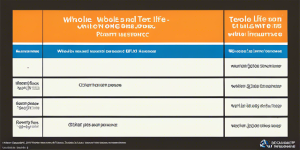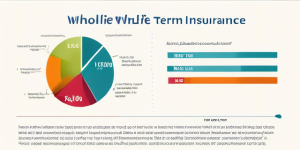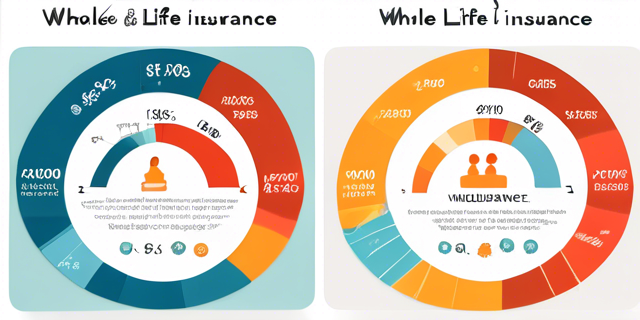Whole vs Term Life Insurance in 2024

Hey there, fellow life-navigator! Are you scratching your head trying to figure out the difference between whole and term life insurance? Don’t worry, you’re not alone. It’s like trying to choose between a smartphone and a flip phone – they both make calls, but oh boy, are they different! In this comprehensive guide, we’ll dive deep into the world of life insurance, comparing whole and term policies as they stand in 2024. So, grab your favorite beverage, get comfy, and let’s unravel this insurance mystery together!
Why Life Insurance Matters in 2024
Before we jump into the nitty-gritty of whole vs term life insurance, let’s talk about why life insurance is more crucial than ever in 2024. In a world where financial uncertainties seem to pop up like weeds in a garden, life insurance serves as a sturdy fence, protecting your loved ones from the harsh elements of financial instability.
Think about it – if you were to suddenly vanish from the picture (a thought none of us like to dwell on), would your family be okay financially? Would they be able to keep a roof over their heads, put food on the table, and continue living the life you’ve worked so hard to provide? That’s where life insurance comes in, acting as a financial safety net for your loved ones.
But here’s the kicker – not all life insurance policies are created equal. Just like you wouldn’t wear flip-flops to climb a mountain, you need to choose the right type of life insurance for your unique situation. And that, my friends, brings us to the main event: whole vs term life insurance.
Understanding Term Life Insurance

What is Term Life Insurance?
Let’s start with term life insurance. If whole life insurance is like buying a house, term life insurance is like renting an apartment. You’re covered for a specific period or “term” – usually 10, 20, or 30 years. If you pass away during this term, your beneficiaries receive the death benefit. If you outlive the term, the policy expires, and that’s that.
Pros of Term Life Insurance
- Affordability: Term life insurance is generally much cheaper than whole life insurance. It’s like buying a ticket to a movie instead of purchasing the entire theater.
- Simplicity: Term policies are straightforward. You pay your premium, and if you die within the term, your beneficiaries get the death benefit. Easy peasy, lemon squeezy!
- Flexibility: You can choose a term that aligns with your specific needs. For example, you might choose a 20-year term to cover your kids until they’re out of college.
- High Coverage Amount: Because it’s more affordable, you can often get a higher coverage amount with term life insurance.
Cons of Term Life Insurance
- No Cash Value: Unlike whole life insurance, term policies don’t build cash value over time. It’s purely protection, no savings component.
- Expiration: If you outlive your term (which is the goal, right?), your coverage ends, and you get nothing back.
- Increasing Premiums: If you decide to renew your policy after the term ends, your premiums will likely increase, sometimes significantly.
Who Should Consider Term Life Insurance?
Term life insurance might be a good fit if you:
- Need coverage for a specific period (like until your mortgage is paid off or your kids are through college)
- Want the most coverage for your money
- Prefer a simpler, more straightforward policy
- Are on a tight budget but still want substantial coverage
Understanding Whole Life Insurance

What is Whole Life Insurance?
Now, let’s talk about whole life insurance. If term life is like renting, whole life is like buying a house. It provides coverage for your entire life (as long as you pay your premiums), and it comes with a savings component called cash value.
Pros of Whole Life Insurance
- Lifelong Coverage: As long as you pay your premiums, you’re covered for life. No need to worry about outliving your policy.
- Cash Value: Part of your premium goes into a savings component that grows over time. It’s like a forced savings account with your insurance policy.
- Fixed Premiums: Your premiums generally remain the same throughout your life, which can be helpful for budgeting.
- Dividends: If you buy a policy from a mutual insurance company, you might receive dividends, which can be used to reduce premiums or increase your death benefit.
Cons of Whole Life Insurance
- Higher Cost: Whole life insurance is significantly more expensive than term life insurance. It’s like buying a mansion when you might only need a cozy apartment.
- Complexity: These policies can be more complex, with various options for using the cash value component.
- Lower Initial Death Benefit: Because of the cash value component, the initial death benefit is often lower than what you could get with a term policy for the same premium.
Who Should Consider Whole Life Insurance?
Whole life insurance might be a good fit if you:
- Want coverage that lasts your entire life
- Are looking for a forced savings vehicle
- Have maxed out other tax-advantaged savings options
- Want to leave a guaranteed inheritance
- Have a high net worth and are looking for estate planning tools
The Cash Value Component: A Closer Look

One of the key differences between whole and term life insurance is the cash value component in whole life policies. Let’s dive a little deeper into this feature.
How Cash Value Works
When you pay your premium for a whole life policy, a portion goes towards the insurance cost, and the rest goes into a savings component called cash value. This cash value grows over time, usually at a guaranteed rate.
Accessing the Cash Value
You can access this cash value in several ways:
- Policy Loans: You can borrow against your cash value, often at favorable interest rates.
- Withdrawals: You can withdraw money directly from your cash value, although this may reduce your death benefit.
- Surrender: If you no longer need the policy, you can surrender it and receive the cash value (minus any surrender fees).
- Paid-Up Additions: Some policies allow you to use the cash value to purchase additional coverage.
It’s important to note that accessing your cash value can have tax implications and may affect your death benefit. Always consult with a financial advisor before making these decisions.
Term vs Whole Life: A Side-by-Side Comparison

Now that we’ve broken down each type of insurance, let’s put them side by side for an easy comparison:
| Feature | Term Life | Whole Life |
|---|---|---|
| Duration | Specific term (e.g., 10, 20, 30 years) | Lifetime |
| Cost | Lower premiums | Higher premiums |
| Cash Value | No | Yes |
| Flexibility | More flexible | Less flexible |
| Simplicity | Simpler | More complex |
| Investment Component | No | Yes |
| Guaranteed Death Benefit | Yes (if death occurs during term) | Yes (as long as premiums are paid) |
Factors to Consider When Choosing Between Whole and Term Life Insurance
Choosing between whole and term life insurance is like deciding between a Swiss Army knife and a chef’s knife. Both are useful, but which one you need depends on what you’re trying to cut! Here are some factors to consider:
- Your Age: Younger individuals often opt for term life insurance due to lower premiums and higher coverage amounts.
- Your Health: If you’re in excellent health, you might get better rates with term insurance. If you have health issues, a whole life policy might be easier to qualify for.
- Your Financial Goals: Are you looking for pure protection or a combination of protection and investment?
- Your Budget: Can you afford the higher premiums of whole life insurance, or does term life fit better with your current budget?
- Your Dependents: How long will others rely on your income? This can help determine if you need coverage for a specific term or your entire life.
- Your Estate Planning Needs: Whole life insurance can be a useful tool for estate planning, especially for high-net-worth individuals.
The Role of Riders in Customizing Your Policy

Both whole and term life insurance policies can be customized with riders. Think of riders as add-ons to your policy, like choosing extra toppings for your pizza. Some common riders include:
- Accelerated Death Benefit: Allows you to access part of your death benefit if you’re diagnosed with a terminal illness.
- Waiver of Premium: Waives your premiums if you become disabled and can’t work.
- Child Term Rider: Provides life insurance coverage for your children.
- Guaranteed Insurability: Allows you to purchase additional coverage at specific times without a medical exam.
Riders can add flexibility to your policy, but they also typically increase your premiums. Consider carefully which riders truly add value for your situation.
The Impact of Age and Health on Life Insurance Choices
Your age and health play a significant role in determining not only your premiums but also which type of policy might be best for you.
Age Considerations
- Younger individuals often opt for term life insurance due to lower premiums and higher coverage amounts.
- As you age, term life insurance becomes more expensive, potentially making whole life more attractive.
- Some insurers have age limits for term policies, while whole life policies can often be purchased at any age.
Health Considerations
- If you’re in excellent health, you might get better rates with term insurance.
- If you have health issues, a whole life policy might be easier to qualify for, especially if it’s a guaranteed issue policy.
- Some health conditions might make it difficult to renew a term policy, making whole life a more secure option.
The Financial Stability of Insurance Companies: Why It Matters

When choosing between whole and term life insurance, it’s not just about the policy features – the financial stability of the insurance company matters too. After all, you’re counting on this company to be around decades from now to pay out your claim.
Here are some ways to assess an insurer’s financial strength:
- Check Ratings: Look at ratings from independent agencies like A.M. Best, Moody’s, and Standard & Poor’s.
- Read Financial Reports: Many insurers publish annual reports that can give you insight into their financial health.
- Consider Company History: Companies with a long history of stability might be a safer bet.
Remember, a policy is only as good as the company backing it. Don’t be swayed by low premiums alone – make sure you’re choosing a financially sound insurer.
The Role of Life Insurance in Estate Planning
Life insurance, particularly whole life insurance, can play a crucial role in estate planning. Here’s how:
- Providing Liquidity: Life insurance can provide immediate cash to cover estate taxes and other expenses, preventing the need to sell assets.
- Equalizing Inheritances: If you want to leave a business or property to one heir, life insurance can provide an equal inheritance to others.
- Charitable Giving: Life insurance can be used to leave a significant gift to a charity.
- Wealth Transfer: Some types of life insurance can be used as a tool for tax-efficient wealth transfer to the next generation.
If estate planning is a significant concern for you, whole life insurance might be worth considering due to its permanent nature and cash value component.
The Impact of Economic Factors on Life Insurance Choices
Economic factors can influence whether term or whole life insurance is more attractive. Here are some considerations:
- Interest Rates: When interest rates are low, the guaranteed returns on whole life policies might be more attractive.
- Inflation: High inflation can erode the value of a fixed death benefit over time, potentially making term insurance less attractive for long-term needs.
- Economic Uncertainty: In times of economic uncertainty, the guaranteed nature of whole life insurance might be appealing.
- Market Performance: If the stock market is performing poorly, the steady growth of cash value in a whole life policy might be attractive compared to other investment options.
The Role of Technology in Life Insurance in 2024
Technology is reshaping the life insurance landscape in 2024, affecting both whole and term policies:
- Online Comparisons: It’s easier than ever to compare policies from multiple insurers online.
- AI-Powered Underwriting: Some companies are using artificial intelligence to streamline the underwriting process, potentially leading to faster approvals and more accurate pricing.
- Personalized Policies: Advanced data analytics are allowing insurers to offer more personalized policies based on individual health and lifestyle data.
- Digital Health Integrations: Some insurers are offering discounts for policyholders who use wearable devices to monitor and improve their health.
Common Mistakes to Avoid When Choosing Life Insurance
As we wrap up our journey through the world of whole and term life insurance, let’s look at some common pitfalls to avoid:
- Underestimating Coverage Needs: Don’t just pick a round number. Calculate your actual needs based on your income, debts, and future expenses.
- Focusing Only on Price: While affordability is important, the cheapest policy isn’t always the best. Consider the company’s financial strength and policy features too.
- Not Reviewing Policies Regularly: Your life insurance needs can change over time. Review your coverage periodically to ensure it still meets your needs.
- Neglecting to Read the Fine Print: Make sure you understand all the terms and conditions of your policy, including any exclusions.
- Waiting Too Long to Buy: The younger and healthier you are, the lower your premiums will typically be. Don’t put off buying life insurance.
Conclusion
Whew! We’ve covered a lot of ground, haven’t we? Choosing between whole and term life insurance isn’t always a clear-cut decision. It’s like choosing between a smartphone and a Swiss Army knife – both are useful tools, but which one you need depends on your specific situation.
Term life insurance offers affordable, straightforward protection for a specific period. It’s a great option if you need high coverage amounts on a budget or if you only need coverage for a certain number of years.
Whole life insurance, on the other hand, provides lifelong coverage and includes a cash value component. It’s more expensive but can be a valuable tool for estate planning and building cash value over time.
Ultimately, the right choice depends on your individual circumstances – your age, health, financial goals, and budget. And remember, it’s not always an either/or decision. Some people find that a combination of whole and term policies best meets their needs.
As we navigate the complex world of life insurance in 2024, it’s clear that technology and economic factors are playing an increasingly important role. But at its core, life insurance is still about providing financial protection and peace of mind for you and your loved ones.
So, take the time to assess your needs, compare your options, and don’t hesitate to seek professional advice if you need it. After all, choosing the right life insurance policy is an important step in securing your financial future. Here’s to making informed decisions and sleeping a little easier at night!
FAQs
- Q: Can I convert my term life insurance to whole life insurance? A: Many term policies offer a conversion option, allowing you to convert to a whole life policy without a medical exam. However, the specifics can vary by insurer and policy, so it’s best to check your policy details or speak with your insurance agent.
- Q: What happens to the cash value in a whole life policy when I die? A: Typically, when you die, your beneficiaries receive the death benefit, not the cash value. Any remaining cash value usually reverts to the insurance company. However, some policies offer options to include the cash value in the death benefit.
- Q: Is it possible to have both whole and term life insurance? A: Absolutely! Some people find that a combination of whole and term policies best meets their needs. For example, you might have a whole life policy for lifelong coverage and add a term policy during years when you need extra coverage (like when your children are young).
- Q: How does the cash value growth in whole life insurance compare to other investments? A: Cash value in whole life insurance typically grows at a guaranteed rate, which is often lower than potential returns from more aggressive investments like stocks. However, it’s also generally safer and can provide tax advantages. It’s best to view it as a conservative part of your overall financial portfolio rather than your primary investment vehicle.
- Q: Can I lose my coverage if I miss a premium payment? A: Policies typically have a grace period (often 30 days) during which you can make up a missed payment without losing coverage. For whole life policies, if you’ve accumulated enough cash value, you might be able to use that to cover premiums temporarily. However, consistently missing payments can indeed result in a lapsed policy and loss of coverage.

